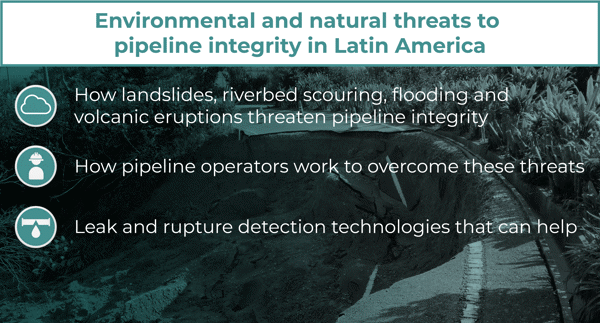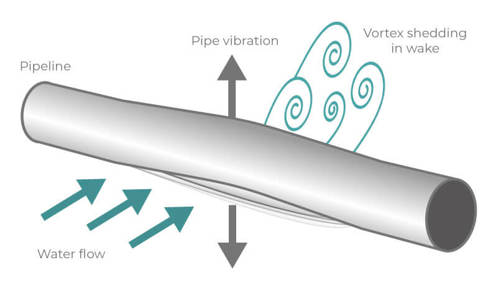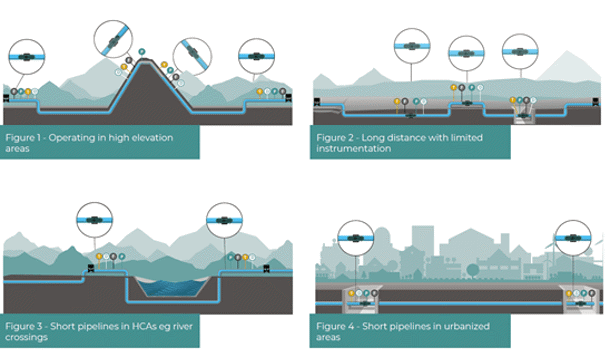Transport by pipelines is one of the safest and most efficient ways to move products. Working all over the world, we know that some pipelines must go through remote or high consequence areas (HCAs).
In addition to this, in some countries there are more severe environmental threats to the integrity of the pipelines. Rupture and leak detection technology can help mitigate the effects of a leak or rupture in the pipeline by detecting them quickly and providing pipeline operators with an accurate location. In this article we’ll explore:
- The key environmental threats to pipeline integrity
- How pipeline operators work to overcome these threats
- Leak and rupture detection technologies that can help

The key environmental threats to pipeline integrity
Natural events can pose a severe threat to pipeline infrastructure. Although pipelines are robust and transport required energy and utility resources through extremely challenging conditions, there are additional environmental threats that can have a negative effect on the infrastructure.
In places such as Latin America, pipeline operators must contend with a long list of challenges including:
- Landslides
- Riverbed scour and underground erosion
- Severe flooding
- Volcano eruptions
Landslides
Some pipeline corridors pass through areas that are highly susceptible to landslides1. They can cause significant damage to the pipeline and don’t need to be large to be destructive.
There are several causes for landslides including heavy rainfall, broken pipelines, grading, inadequate drainage, earthquakes and erosion. Pipelines that exist in areas such as the Andes Mountains must contend with the high probability of landslides due to the seismic activity and frequent flash floods.
Being so close to the Amazon, the world’s most important ecosystem, makes the protection of pipelines ever more important. There are many indigenous people who live in proximity and of course the natural habitat that could take years to recover from any environmental damage.
Areas in Bolivia also suffer from frequent flash floods, leading to landslides. The rupture of a gas pipeline caused by a landslide affected the supply of gas for several organizations in the industrial sector last year8.
Riverbed scour and underground erosion
There are two main types of erosion that impact pipelines, riverbed scour and underground erosion. Riverbed scour is the erosion of the riverbed (vertical scour) or riverbanks (lateral scour) by flowing water2. It occurs gradually but is accelerated by flooding. The resistance of the riverbed material determines at which rate the scour will occur. After a pipeline has been exposed by scouring, it’s vulnerable to the impact from passing debris, particularly during times when there is a high-flow due to flash floods.
Recently in Ecuador riverbed scour and subsequent erosion resulted in three ruptured oil pipelines3. The pipelines ruptured due to landslides along the river, spilling around 57,000 liters of oil.
Areas in Ecuador like this are susceptible to large landslides due to the geography and climate. There’s also volcanic activity, seismic activity and frequent flash floods4, which all threaten the pipelines that have been built.
Underground erosion creates linear cavities, in a process known as piping7. This is where soil is carried away by seeping ground water. The activity underground like this, causes significant stress changes around the pipeline, again, impacting the integrity and areas of weakness along the pipeline, particularly when you consider factors like aging too.
Severe flooding
If river-crossing pipelines become exposed due to riverbed scouring, it isn’t just passing debris that poses a risk. The pipelines may also experience vibration due to the fast-flowing water, this is known as vortex-induced vibration (VIV)2. VIV puts the pipeline under added stress and starts to weaken the integrity of the pipeline. This can also be a challenge for subsea pipelines contending with currents, the integrity must be managed to reduce fatigue damage.

Figure 1: Vortex-induced vibration (VIV)
Flooding contributes towards inducing landslides as mentioned above, with the heavy rain causing the ground shift and swell. In addition, the floodwaters can make it increasingly challenging for pipeline operators to access the leak location and repair the pipeline.
Volcanic eruption
Volcanos also pose a threat in some areas of Latin America. This is a vital consideration for the safety of the pipelines within striking distance. In Ecuador, several sections of crude oil pipeline are buried to help protect them from this threat5.
The volcanic eruptions can also trigger other threats such as floodwaters and landslides, a high risk to the pipelines.
How pipeline operators work to overcome these threats
Considering environmental threats is a crucial aspect of pipeline integrity management (PIM). An effective mitigation plan details the acceptable level of risk for the pipeline. There are several activities that can be taken during the construction stage of the pipeline such as properly assessing the topology of the landscape in relation to where the pipeline corridor will be. Pipeline operators can consider alternative routes and alignments if the proposed ones will pose a high risk.
There’s also the proper maintenance of the pipeline, working with subject matter experts from environmental fields and forming partnerships with the stakeholders to resolve issues that the proposed pipeline corridor might cause.
Of course, one can only consider so many of these aspects for pipelines that already exist. That’s why it’s important to have knowledge of the rules, regulation and laws for the location of the pipeline. Part of responsible PIM for some of the areas and challenges mentioned is about having a leak detection system (LDS) on your pipeline so that you can detect and locate leaks or ruptures quickly, minimizing the impact on the surrounding environment.
Leak and rupture detection technologies that can help
Part of mitigating the risks against the key environmental threats to pipelines is about having an effective and reliable LDS and rupture detection system. Threats like landslides can occur very quickly, even if the causes take a while to materialize.
Will all these threats, the challenge lies in not only detecting the leak, but then finding it. If a pipeline is subject to a landslide, it may be buried under soil and debris. Similarly, if the pipeline is impacted by riverbed scour, pinpointing the location will be difficult, especially if there’s a high-flow.
Atmos Pipe is a reliable LDS that uses the powerful Sequential Probability Ratio Test (SPRT) with pressure and flow analysis to optimize leak detection. It’s a field proven technology of over 25 years, on more than 1,500 pipelines. The software uses flow and pressure data from SCADA, DCS, PLC or RTU systems.
There are also solutions that use both the negative pressure wave (NPW) and volume balance methods like Atmos Wave Flow. As an LDS, this makes it multi-element, which helps to reduce uncertainty and improve performance. Using this model, Atmos Wave Flow provides accurate leak detection and location in a short time.
Considering the remote and high consequence areas (HCAs) where some of the pipelines in Latin America and other areas run through, hardware can add another layer of reliability and sensitivity to the LDS.
Atmos Eclipse provides non-intrusive instrumentation as part of your overall PIM strategy. It is ideal for pipelines that have a lack of communication, power, instrumentation and housing for equipment. Working with our software, Atmos Eclipse aims to improve sensitivity, response time and leak location accuracy.

Figure 2: A variety of scenarios where Atmos Eclipse can be installed for remote monitoring
The robust hardware works in challenging climates, operating in -20 C to 60+ C temperatures. The communications capabilities means that its ideal for the HCAs of Latin America.
References
1https://pubs.usgs.gov/of/2008/1164/pdf/OF08-1164_508.pdf
4https://www.amazonfrontlines.org/chronicles/real-price-oil-amazon/
5https://www.argusmedia.com/en/news/1120920-ecuador-buries-oil-pipelines-in-volcano-path
